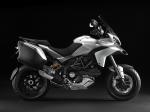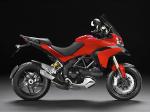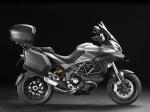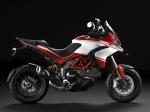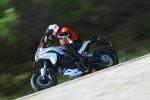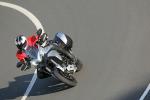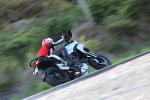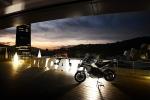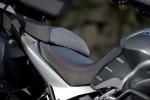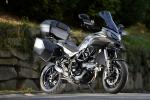Ducati 2013 Multistrada MTS1200
By Kevin Ash - 11/01/2011
Multistrada: for many riders, all the motorcycle they could ever need. Fast, comfortable and versatile like nothing before, a technical and dynamic tour de force, and now Ducati has presumed to make it better.
The Multi might have been magnificent but it wasn't perfect, so existing owners are looking closely to see if its quirks and flaws have been addressed, if indeed Ducati has been listening to them. And as a technical pathfinder, the MTS1200 could hardly be revisited without pushing forward the bounds of motorcycle engineering once again.
The new Multistrada has certainly done the latter. All Multistrada S models now come with a motorcycling co-first (along with BMW's HP4 - review here), semi-active suspension called Ducati Skyhook (DSS). This is a derivation of the "skyhook" technology which has been established for several years in the car world.
Comprehensive 2013 Multistrada technical feature here!
In essence, the system constantly strives to keep the chassis stable in relation to an imaginary datum point in the air above the bike - the skyhook - by adjusting the suspension damping rates according to a wide range of parameters.
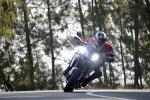
The DSS system does this continuously over an extraordinarily wide range, far greater than that available with conventional adjusters. Brake hard and the forks are stiffened, accelerate and the rear shock damping is increased, while the system also responds to the road surface and the bike's speed. It happens constantly and very rapidly all the time the bike is being ridden.
The rest of the bike's electronics have been upgraded, and include the latest version of Bosch's 9ME ABS system, which comes with three levels of intervention. The eight-level DTC traction conrol system has been refined, with torque reduction of up to 60 per cent now controlled by retarding the ignition, and the fuel injection then being interrupted for greater levels than that. Previously the injection came into play at lower levels of torque reduction, which resulted in a harsher DTC operation.
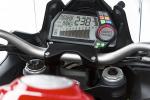
As with the previous Multistrada, changes in the levels of these systems are made automatically when the rider switches between the Sport, Touring, Urban and Enduro riding modes, along with adjustments to the rear spring preload, but it‘s possible to personalise all of the settings within each of these modes. The Skyhook system is able to utilise the full range of available damping adjustment regardless of the mode selected, but its base point moves to suit the active mode. More on this too in the Multistrada technical feature.
There has been a range of other changes to the bike, many in response to feedback from existing owners, including those in the ashonbikes Multistrada forum thread, which has been looked at regularly by Ducati over the last few years. Ducati technical director Andrea Forni has addressed a selection of questions from the forum here, and there are some fascinating and very direct answers!

The Testastretta 11 degree engine made its debut in the Multistrada MTS1200, and is so called because of its 11 degrees of valve overlap, the main distinction between it and the 1198 superbike engine from which it was derived. For the 2013 model a second spark plug has been fitted in each cylinder, a move designed to provide smoother and more efficient combustion. The fuel injectors have been re-angled to direct their charge straight at the hot inlet valves to improve atomisation for more consistent fuelling.
To allow the mixture to be enriched in some situations without exceeding emissions regulations, a secondary air bleed system similar to the Panigale's has been introduced. Ducati says as a result of all this, peak power of what it calls the second generation Testastretta 11 degree is unchanged but torque has been boosted by up to five per cent, increasing 0.7kgm to 12.7kgm at 7,500rpm. Economy is better too, by 10 per cent at a steady 55mph (90kph) as well as by useful amounts at more realistic cruising speeds. Another important aim was to improve the smoothness and consistency of the power delivery.
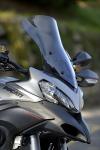
There's a package of changes at the front of the bike. This includes the fitment of LED dipped headlights, which reduce the current demand from 9A to 2A. In turn, this means the dipped lights now stay illuminated when the rider switches to main beam, as the drain on the electrical system is no longer excessive with all the lights blazing, giving a brighter and larger spread of light. The main beam lights themselves are the same as before. The screen has been changed for one designed to offer better wind protection and lower noise levels, it's 18mm higher, 43mm wider and is height-adjustable over 60mm, the same as the outgoing model, but very quickly using just one hand via a latch behind its centre. The upper fairing panel has been redesigned subtly to accommodate these new features as well as slightly larger storage compartments, otherwise the bike's bodywork is the same as before. There's also a new seat which provides more fore and aft space for the rider - a criticism of the old model was that the seat was too short for many riders.
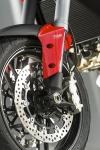
As well as the three-level Bosch ABS, which uses the same processor as the Panigale‘s, the braking system has had other changes including combined braking distribution which sees the rear brake operating with the front when only the handlebar lever is used - this occurs in Touring and Urban modes but not the other two. The rear brake itself has been modified to deal with issues the old model had with weak or non-existent operation due to bleeding problems.
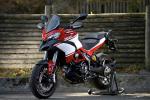
The wheels are new 10-spoke items similar in style to the Panigale's, although the sportiest Pikes Peak model is fitted with forged, three-spoke Marchesini wheels which reduce the weight by a total of 2.5kg. The Multistrada MTS1200 S Pikes Peak, to give it its full title, is the sole sports version of the Multistrada for 2013, and as well as the different wheels it gets a cut down screen and Termignoni silencer, both in carbon fibre along with various other components such as cambelt covers, front mudguard, rear hugger, front air intakes and so on. The seat is unique to this model and comes with red stitching.
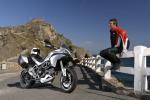
The 1200 S Touring, as tested, is to the same spec as the previous model, so it comes with a centre stand, 29 litre panniers, heated grips and the full electronics package, while the base model MTS1200 does without the skyhook system and luggage but still gets the choice of engine modes with the eight-level traction control and three-level ABS, billed as the Ducati Safety Pack.
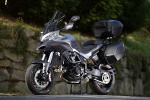
The new model is the MTS1200 S Granturismo. This is likely to cost around £16,300, and for that you get larger 36 litre panniers, a 48 litre top box (all with interior soft bags), a Ducati Performance comfort seat, 20mm higher bars and a larger screen. The bike also debuts Pirelli's new Angel GT touring tyres, claimed to have a 15 per cent longer life than the Scorpions fitted to the other Multistrada models. Other features include LED spotlights and engine protection bars.
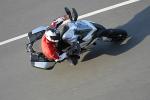
Only one model was available on Ducati‘s press presentation in Bilbao, the 1200 S Touring, and the bike has a problem, manifested by an atmosphere of being underwhelmed among some of the journalists. It‘s a good problem though: the original Multistrada is such a complete and staggeringly accomplished motorcycle, it‘s very difficult to improve on in more than detail. But those details do matter a lot to the Multistrada cognoscenti, who will be very pleased to hear Ducati has done a fabulous job in putting right most of their gripes with the old model.
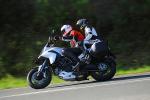
The suspension is a good example. Never mind the skyhook technology, the most significant change for many existing owners is the replacement of the previous Ohlins single rate rear spring with a progressive one - rated at 85-125N/mm.
Andrea Forni explains in an exclusive interview...
Full and revealing Forni interview here!
...why there wasn't one fitted before, and why Ducati has switched to Sachs from Ohlins for the 2013 Multistrada. The aim is help the bike cope better with loads greater than a solo rider, and this works very well. With a passenger on board (in this case the svelte form of Performance Bikes' Emma Franklin, although I didn't get to try additional luggage too) the new Multi is significantly more stable and level than before, better controlled at the rear end and on some larger bumps didn‘t threaten to bottom out where previously it would.
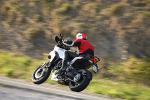
The DSS plays a strong role here too of course. Ride the bike at steady speeds, braking and accelerating gently, and you won‘t detect a great deal of difference. In Sport mode the bike is still firmly sprung and in Touring the ride quality is good if not outstanding. Then switch to Urban and the ride is softens substantially, with the bike floating over bumps, potholes, speed humps and so on with absolute panache. I personalised the Touring mode by moving it towards Urban by one 'notch' on the screen, and the ride quality improved substantially without really compromising stability or handling. Feedback was reduced a little, but not fatally, I'd live with that when Sport mode is only a button push away anyway.

It's when you start to try harder that the skyhook difference starts to show. Squeeze the front brake firmly and the long 170mm travel forks compress less than the 2012 model's, rough surfaces are absorbed better and the bike is much more composed. Accelerate hard and the tendency to wheelie is reduced, while the bike remains more controlled in pitch whatever you‘re doing. Large bumps in particular are absorbed more effectively, although you tend to counter that by running over them faster in the first place, but the most significant difference comes in two-up riding. Motor Cycle News‘ unfeasibly tall photographer Ian Jubb was given a lift along a rough track, and with the Multi still in Sport mode was staggered at the serenity of the bike as the wheels beneath were pounding up and down on the unmade surface. The ride quality two-up is extraordinarily good, while the general feel of the bike in normal, solo conditions is of a top quality, fine handling motorcycle with a conventional amount of wheel travel, with a secret reserve of extra suspension movement to call upon when needed.

What you lose was evident on the semi-active-equipped HP4 and on bikes with Big Piston forks, which is the eagerness to turn in that comes with sharpening geometry as forks compress. It‘s a bit more effort to pull the Multistrada over into a turn, and when it‘s there there‘s a stronger tendency to stand up on the brakes if you apply them. Overall though, DSS has in effect expanded the range of conditions over which the suspension works very well, rather than improving it significantly within normal, solo riding. And given the Multistrada‘s multi-purpose role, that's exactly what it should be doing. As a clue to how much damping range the system can call upon, just try bouncing a Multistrada on its suspension when the ignition is switched off (when it defaults to maximum damping): it feels like the forks and shock are filled with setting concrete! You don't remotely close to this with conventional suspension.
The bike is still the great pleasure it always was to hurl around on a sinuous road, and bear in mind, for any talk of slightly slower steering on the brakes (and this is minimal anyway) the MTS1200 is nearly 90lb (40kg) lighter than a Triumph Tiger Explorer, practically a compact passenger's worth, and will run small radius rings around other adventure bikes. Oddly, the agility is aided by the new seat too. The rider‘s section has been made longer, which makes it easier to move your weight side to side as well as improving comfort generally. Some riders found it pushed them too far forward, but they're unlikely to find this is the case with the new version. In other respects it's as you were, which means exceptionally comfortable, although shorter riders might find the reach to the ground is a touch high.
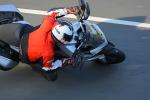
There have been plenty of aftermarket attempts at reducing noise from the old Multistrada's screen, with no great success, and Ducati hasn't got this completely licked with its own new screen. But it is better. The wind shadow behind it is larger, offering more protection across the shoulders in particular, and for shorter riders than 6'3"� (1.91m) me, the noise levels with the screen raised fully should be significantly less. I never had huge issues with the old model's screen noise but I can say the new one is quieter, and better for me at higher speeds at its lowest level. Adjusting the height is so easy you find yourself doing so regularly - just squeeze a clip in the centre and slide it up or down, all with one hand and while riding, and that‘s it.
The engine's not been missed out in the 2013 refresh, and for me this is the biggest improvement over the old model. Make no mistake, the Multistrada's engine has always been one of the most exciting and enjoyable power units you could find in a motorcycle, but there was a rough edge to it which sat a little incongruously in the otherwise highly sophisticated machine. At lower revs in particular it could feel harsh and lumpy, and early examples used to hunt on a steady, light throttle.
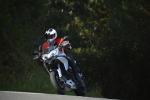
The new version is much smoother at low revs with a more consistent feel and no sense of unhappiness at being used gently. It doesn't have the bubbling chocolate, muscular character of the Diavel (which the cruiser gets from having a heavier flywheel), but it's closer to that now, while revving more eagerly. There is also not the slightest hint of any kind of surging or hunting at any speeds, even on the lightest throttle openings. The increase in torque isn't really noticed, although that could be because the smoother throttle response has disguised the additional thrust. But not too much... this is still a shockingly punchy bike in the low and mid-range with a blast of power when you rev it hard that's not far shy of a full-on superbike's. It used to be one of the great engines in motorcycling, and now it's just got even better.
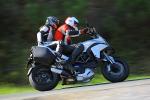
So what hasn't changed that might have been? The panniers are the same as before, with latches at the front and rear in addition to the central locking one - these were added as a temporary fix for lids that didn't close properly, but it looks like they're with us for good. There's still restricted space for your right foot on bikes with a centre stand, although this is better than on the early models after a mid-model-run modification. Passenger foot space is restricted too when the panniers are fitted, otherwise the rear seat comfort is good and hasn't suffered for the loss of a little space to the rider.
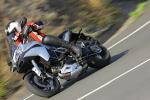
The new 2013 Multistrada hasn't wowed the press in the same way as the original, largely because expectations of something with a very special and obviously different feel from the semi-active suspension weren't fully met. In fact the system is more subtle than that, dealing with extremes with unobtrusive efficiency and coping with additional loads far better than the outgoing model while helping the bike maintain its poise beyond the point where suspension travel this long would normally start to struggle.
There's also the fact that the first Multistrada rocked us all with its brilliance, yet the new one is merely incrementally better. But it's better in almost all the places where owners have asked for it to be, and nothing that made the first one probably the best motorcycle in the world has changed or diminished. Which means it's still the best motorcycle in the world.
Ashonbikes Multistrada Forum
Related Links
Multistrada Skyhook Technical Feature
Original Multistrada press launch review
Specifications
Model tested: Ducati Multistrada MTS1200 S Touring 2013
UK price: £15,195 (MTS1200, £12,395;Pikes Peak, £17,250; GT £16,300 est)
Available: January 2013
Engine: 90-degree V-twin, liquid cooled, desmodromic dohc 8v, 1198cc
Power: 148bhp (150PS, 110.3kW) @ 9,250rpm
Torque: 92lb.ft (12.7kgm, 124.5Nm) @ 7,500rpm
Economy: 47mpg (16.6km/l, 6.0l/100km, 39mpg US) (est)
Tank/Range: 4.4 gallon (20 litres, 5.3 gallons US) / 205 miles (330km)
Transmission: Six gears, wet multi-plate clutch, chain final drive
Chassis: tubular steel trellis
Seat height: 33.5in (850mm)
Wheelbase: 60.2in (1530mm)
Rake/trail: 25 ° / 4.3in (110mm)
Weight: 516lb (234kg) wet, 90% full tank
All model weights:
MTS1200 - 224kg (494lb) wet, 196kg (432lb) dry
MTS 1200S Touring - 234kg (516lb) wet, 206kg (454lb) dry
MTS 1200 GT - 245kg (540lb) wet, 217kg (478lb) dry
MTS 1200 PP - 222kg (489lb) wet, 194kg (428lb) dry
Donate to the Kevin Ash Fund
Kevin's funeral was held on Thursday 28th February 2013 and was well attended by family, friends and colleagues.
The Telegraph has very kindly established The Telegraph Kevin Ash Fund to assist with the education of Kevin's three daughters.
If you'd like to make a donation then you can use the PayPal 'Donate' button below which will allow you to donate from your PayPal account, or via credit or debit card. A small percentage (about 3.4%) will be retained by PayPal for the service.
Kevin's family have been touched by the generosity and messages of support from people using the website and would like to express their gratitude to those who have contributed in any way.
The donations keep coming in, thank you so much, and the family especially like it when you leave a message.
Home | ![]() facebook.com/KevinAshFund
|
facebook.com/KevinAshFund
| ![]() twitter.com/KevinAshFund | © 2011
twitter.com/KevinAshFund | © 2011
